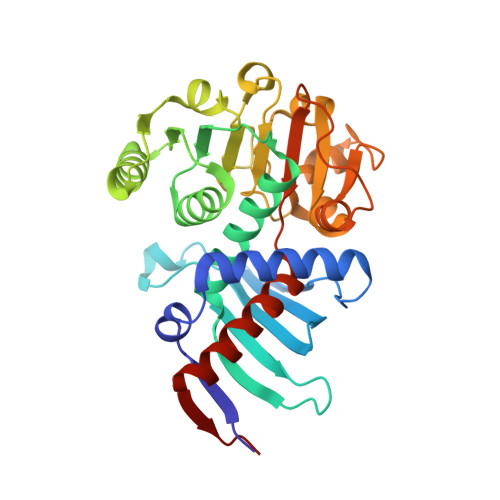Structure of alanine dehydrogenase from Archaeoglobus: active site analysis and relation to bacterial cyclodeaminases and mammalian mu crystallin.
Gallagher, D.T., Monbouquette, H.G., Schroeder, I., Robinson, H., Holden, M.J., Smith, N.N.(2004) J Mol Biol 342: 119-130
- PubMed: 15313611
- DOI: https://doi.org/10.1016/j.jmb.2004.06.090
- Primary Citation of Related Structures:
1OMO - PubMed Abstract:
The hyperthermophilic archaeon Archaeoglobus fulgidus contains an L-Ala dehydrogenase (AlaDH, EC 1.4.1.1) that is not homologous to known bacterial dehydrogenases and appears to represent a previously unrecognized archaeal group of NAD-dependent dehydrogenases. The gene (Genbank; TIGR AF1665) was annotated initially as an ornithine cyclodeaminase (OCD) on the basis of strong homology with the mu crystallin/OCD protein family. We report the structure of the NAD-bound AF1665 AlaDH (AF-AlaDH) at 2.3 A in a C2 crystal form with the 70 kDa dimer in the asymmetric unit, as the first structural representative of this family. Consistent with its lack of homology to bacterial AlaDH proteins, which are mostly hexameric, the archaeal dimer has a novel structure. Although both types of AlaDH enzyme include a Rossmann-type NAD-binding domain, the arrangement of strands in the C-terminal half of this domain is novel, and the other (catalytic) domain in the archaeal protein has a new fold. The active site presents a cluster of conserved Arg and Lys side-chains over the pro-R face of the cofactor. In addition, the best ordered of the 338 water molecules in the structure is positioned well for mechanistic interaction. The overall structure and active site are compared with other dehydrogenases, including the AlaDH from Phormidium lapideum. Implications for the catalytic mechanism and for the structures of homologs are considered. The archaeal AlaDH represents an ancient and previously undescribed subclass of Rossmann-fold proteins that includes bacterial ornithine and lysine cyclodeaminases, marsupial lens proteins and, in man, a thyroid hormone-binding protein that exhibits 30% sequence identity with AF1665.
Organizational Affiliation:
Biotechnology Division of the National Institute of Standards and Technology, Gaithersburg, MD 20899-8312, USA. [email protected]
















